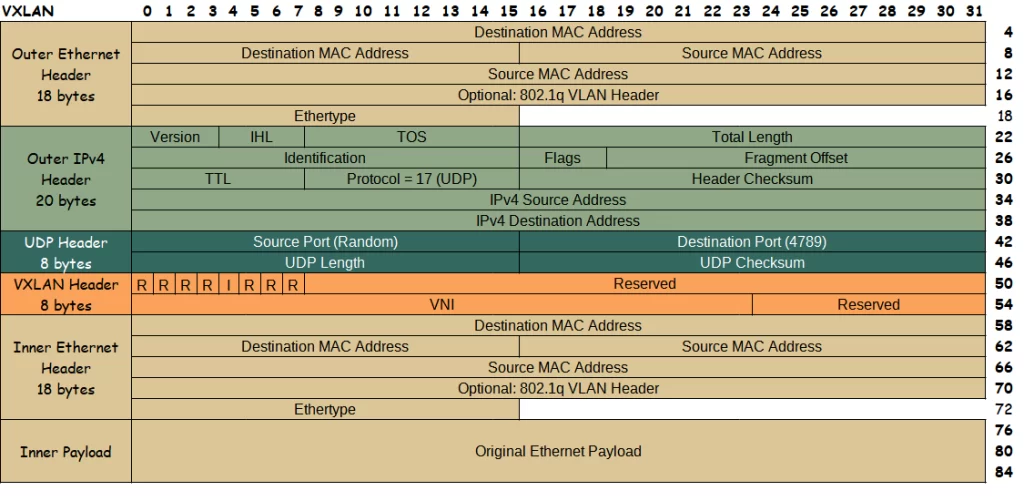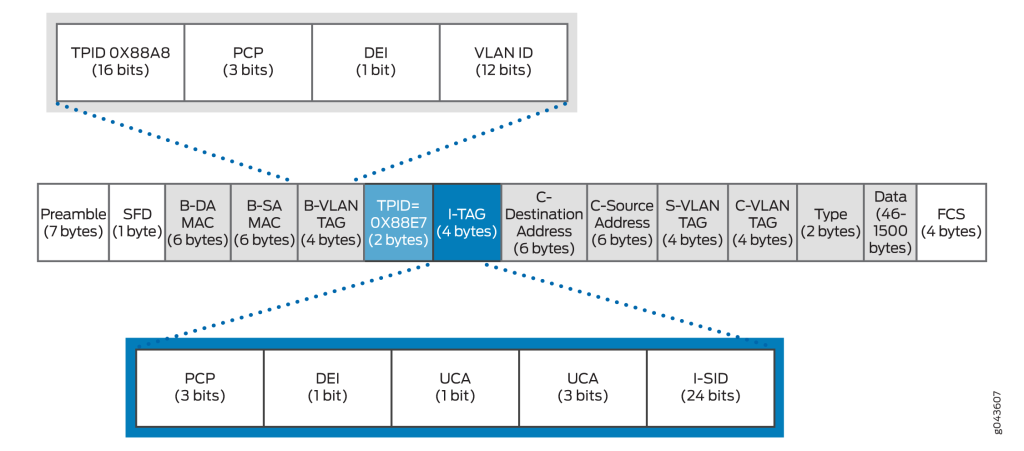1: VLAN-Based Service
Figure 2: VLAN Bundle Service
Figure 3: VLAN-Aware Bundle Service
1: VLAN-Based Service
Figure 2: VLAN Bundle Service
Figure 3: VLAN-Aware Bundle Service


interfaces {
apply-groups [ interfaces-100g interfaces-10g interfaces-1g ];
et-0/0/24 {
apply-groups [ ESI-PORT ];
apply-groups-except MTU-VXLAN;
description "Internal: to sw2.et-0/0/51";
mtu 9216;
gigether-options {
fec fec91;
}
flexible-vlan-tagging;
encapsulation flexible-ethernet-services;
esi {
00:11:11:11:11:11:11:11:11:10;
}
unit 1850 {
encapsulation vlan-bridge;
vlan-id 1850;
}
unit 1851 {
encapsulation vlan-bridge;
vlan-id 1851;
}
unit 1852 {
encapsulation vlan-bridge;
vlan-id 1852;
}
unit 1853 {
encapsulation vlan-bridge;
vlan-id 1853;
}
}
}routing-instances {
evpn-100 {
instance-type mac-vrf;
protocols {
evpn {
encapsulation vxlan;
extended-vni-list all;
}
}
vtep-source-interface lo0.0;
service-type vlan-aware;
route-distinguisher 10.255.252.0:100;
vrf-import IMPORT-POLICY-100;
vrf-target target:64999:100;
vlans {
bd-100-1850 {
vlan-id 1850;
interface et-0/0/24.1850;
vxlan {
vni 1850;
encapsulate-inner-vlan;
}
}
bd-100-1851 {
vlan-id 1851;
interface et-0/0/24.1851;
vxlan {
vni 1851;
encapsulate-inner-vlan;
}
}
bd-100-1852 {
vlan-id 1852;
interface et-0/0/24.1852;
vxlan {
vni 1852;
encapsulate-inner-vlan;
}
}
bd-100-1853 {
vlan-id 1853;
interface et-0/0/24.1853;
vxlan {
vni 1853;
encapsulate-inner-vlan;
}
}
}
}
}policy-options {
policy-statement EXPORT-POLICY-100 {
term ROUTE-TARGET {
then {
community add RT100;
}
}
}
policy-statement IMPORT-POLICY-100 {
term ROUTE-TARGET-iBGP {
from community RT100-iBGP;
then accept;
}
}
community RT100 members [ target:65001:100 target:64999:100 ];
community RT100-eBGP members target:65001:100;
community RT100-iBGP members target:64999:100;
}groups {
ESI-PORT {
interfaces {
<*> {
esi {
all-active;
}
}
}
}
interfaces-100g {
<et-*> {
description "Reserved for 100 GbE port speeds";
disable;
}
}
interfaces-10g {
<xe-*> {
description "Reserved for 10 GbE port speeds";
disable;
}
}
interfaces-1g {
<ge-*> {
description "Reserved for 1 GbE port speeds";
disable;
}
}
}forwarding-options {
evpn-vxlan {
shared-tunnels;
}
}protocols {
l2-learning {
decapsulate-accept-inner-vlan;
}
bgp {
group ipv6-backbone {
family evpn {
signaling;
}
}
group ipv4-backbone {
family evpn {
signaling;
}
}
}
}At the beginning of 2021, Namex IXP has started the rollout of its next-generation peering platform, the active infrastructure which is at the core of its network interconnection facility. This new platform relies on an IP fabric design with VXLAN as the overlay network and BGP EVPN as the control plane protocol. The development of this project started back in March 2020 and saw Mellanox and Cumulus Networks (both parts of NVIDIA corporation now) as major technological partners.
Before diving into the details, a brief historical note may help to understand the drivers and motivations behind such technical choices.
More at “Switching” to IP fabrics – Namex Bits – https://blog.namex.it/2021/04/switching-to-ip-fabrics/
Today we're testing EVPN route policy filtering in JUNOS. Recently released in 19.4R1, this feature will help get around the issue of L2 on spines spanning multiple data centres to enhance forwarding behaviour 😁
— Dan Hearty (@danhearty) January 23, 2020